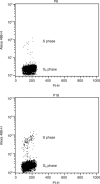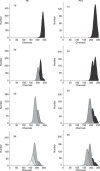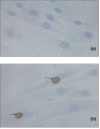In vitro polydeoxyribonucleotide effects on human pre-adipocytes
- PMID: 18673371
- PMCID: PMC6496018
- DOI: 10.1111/j.1365-2184.2008.00547.x
In vitro polydeoxyribonucleotide effects on human pre-adipocytes
Abstract
Objectives: Adipose tissue is the most abundant and accessible source of adult stem cells. Human processed lipoaspirate contains pre-adipocytes that possess one of the a characteristic pathways of multipotent adult stem cells and are able to differentiate in vitro into mesenchymal and also neurogenic lineages. Because stem cells have great potential for use in tissue repair and regeneration, it would be significant to be able to obtain large amounts of these cells in vitro. As demonstrated previously, purine nucleosides and nucleotides mixtures can act as mitogens for several cell types. The aim of this study was to evaluate the effects of polydeoxyribonucleotides (PDRN), at appropriate concentrations, on human pre-adipocytes grown in a controlled medium, also using different passages, so as to investigate the relationship between the effect of this compound and cellular senescence, which is the phenomenon when normal diploid cells lose the ability to divide further.
Materials and methods: Human pre-adipocytes were obtained by liposuction. Cells from different culture passages (P6 and P16) were treated with PDRN at different experimental times. Cell number was evaluated for each sample by direct counting after trypan blue treatment. DNA assay and the 3-(4,5-dimethylthiazol-2-yl)-2,5-diphenyltetrazolium bromide test were also carried out in all cases.
Results and conclusions: PDRN seemed to promote proliferation of human pre-adipocytes at both passages, but cell population growth increased in pre-adipocyte at P16, after 9 days as compared to control. Our data suggest that PDRN could act as a pre-adipocyte growth stimulator.
Figures










Similar articles
-
Polydeoxyribonucleotide (PDRN) promotes human osteoblast proliferation: a new proposal for bone tissue repair.Life Sci. 2003 Aug 29;73(15):1973-83. doi: 10.1016/s0024-3205(03)00547-2. Life Sci. 2003. PMID: 12899922
-
Herbal pre-conditioning induces proliferation and delays senescence in Wharton's Jelly Mesenchymal Stem Cells.Biomed Pharmacother. 2017 Sep;93:772-778. doi: 10.1016/j.biopha.2017.06.107. Epub 2017 Jul 15. Biomed Pharmacother. 2017. PMID: 28724259
-
Polydeoxyribonucleotide enhances the bioactivities of stem cells from human exfoliated deciduous teeth through Akt activation.Biochem Biophys Res Commun. 2024 Dec 20;739:150947. doi: 10.1016/j.bbrc.2024.150947. Epub 2024 Nov 7. Biochem Biophys Res Commun. 2024. PMID: 39550860
-
Silencing of the small GTPase DIRAS3 induces cellular senescence in human white adipose stromal/progenitor cells.Aging (Albany NY). 2017 Mar 17;9(3):860-879. doi: 10.18632/aging.101197. Aging (Albany NY). 2017. PMID: 28316325 Free PMC article.
-
Mesengenic potential and future clinical perspective of human processed lipoaspirate cells.J Nippon Med Sch. 2003 Aug;70(4):300-6. doi: 10.1272/jnms.70.300. J Nippon Med Sch. 2003. PMID: 12928709 Review.
Cited by
-
One-Stage Immediate Breast Reconstruction: A Concise Review.Biomed Res Int. 2017;2017:6486859. doi: 10.1155/2017/6486859. Epub 2017 Oct 2. Biomed Res Int. 2017. PMID: 29098159 Free PMC article. Review.
-
Activity of Experimental Mouthwashes and Gels Containing DNA-RNA and Bioactive Molecules against the Oxidative Stress of Oral Soft Tissues: The Importance of Formulations. A Bioreactor-Based Reconstituted Human Oral Epithelium Model.Molecules. 2021 May 17;26(10):2976. doi: 10.3390/molecules26102976. Molecules. 2021. PMID: 34067773 Free PMC article.
-
Adipose-derived stem cells for clinical applications: a review.Cell Prolif. 2011 Feb;44(1):86-98. doi: 10.1111/j.1365-2184.2010.00736.x. Cell Prolif. 2011. PMID: 21199013 Free PMC article. Review.
-
Trophic effects of polynucleotides and hyaluronic acid in the healing of venous ulcers of the lower limbs: a clinical study.Int Wound J. 2016 Oct;13(5):754-8. doi: 10.1111/iwj.12368. Epub 2014 Sep 16. Int Wound J. 2016. PMID: 25224018 Free PMC article.
-
Autologous platelet-rich plasma (PRP) in chronic penile lichen sclerosus: the impact on tissue repair and patient quality of life.Int Urol Nephrol. 2017 Apr;49(4):573-580. doi: 10.1007/s11255-017-1523-0. Epub 2017 Feb 4. Int Urol Nephrol. 2017. PMID: 28161837
References
-
- Ashjian PH, Elbarbary AS, Edmonds B, Deugarte D, Zhu M, Zuk PA, Lorenz HP, Benhaim P, Hedrick MH (2003) In vitro differentiation of human processed lipoaspirate cells into early neural progenitors. Plast. Reconstr. Surg. 111, 1922–1931. - PubMed
-
- Astori G, Vignati F, Bardelli S, Tubio M, Gola M, Albertini V, Bambi F, Scali G, Castelli D, Rasini V, Soldati G, Moccetti T (2007) ‘In vitro’ and multicolor phenotypic characterization of cell subpopulations identified in fresh human adipose tissue stromal vascular fraction and in the derived mesenchymal stem cells. J. Transl. Med. 5, 55. - PMC - PubMed
-
- Belletti S, Uggeri J, Gatti R, Govoni P, Guizzardi S (2007) Polydeoxyribonucleotide promotes cyclobutane pyrimidine dimer repair in UVB‐exposed dermal fibroblasts. Photodermatol. Photoimmunol. Photomed. 23, 242–249. - PubMed
-
- Bigliardi P (1982) Treatment of acute radiodermatitis of first and second degrees with semi‐greasy placenta ointment. Int. J. Tissue React. 4, 153–154. - PubMed
-
- Bitto A, Minatoli L, Polito F, Altavilla D, Cattarini G, Squadrito F (2006) Polydeoxyribonucleotide improve angiogenesis and wound healing in experimental burn wounds In: 8th International Symposium on Adenosine and Adenine Nucleotides. Ferrara, Italy: Springer.
MeSH terms
Substances
LinkOut - more resources
Full Text Sources
Other Literature Sources
Medical
Research Materials

